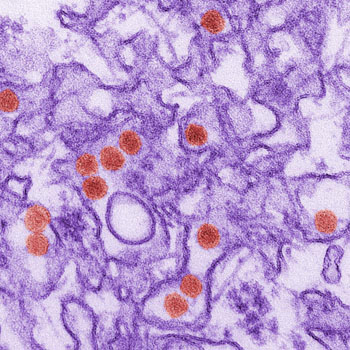Solving the 3D Structure of Zika Virus NS1 May Aid in Vaccine Development
By LabMedica International staff writers
Posted on 10 Aug 2016
A team of molecular virologists has established the crystal structure of the full-length Zika virus NS1 (nonstructural protein 1), a critical virulence protein that functions in genome replication and host immune-system modulation.Posted on 10 Aug 2016
Investigators at the University of Michigan (Ann Arbor, USA) and Purdue University (West Lafayette, IN, USA) had previously isolated and mapped the NS1 protein from dengue and West Nile viruses. In the current study, they used X-ray crystallography and electron microscopy to generate the three-dimensional molecular structure of the Zika virus NS1.

Image: Digitally colorized transmission electron micrograph (TEM) of Zika virus, which is a member of the family Flaviviridae. Virus particles, here colored red, are 40 nanometers in diameter, with an outer envelope, and an inner dense core (Photo courtesy of the CDC).
They reported in the July 25, 2016, online edition of the journal Nature Structural & Molecular Biology that while the Zika NS1 was similar to that of other related viruses, the Zika NS1 structure had a few important differences. One departure from the structure of dengue NS1 was the positioning of flexible loops on the wing domains of the protein.
“From NS1 structure studies in dengue, it was thought this loop flipped up, but our study in Zika virus shows it flips down from the wings,” said contributing author Dr. Richard Kuhn, professor of biological sciences at Purdue University. “This is very important because it indicates an interaction with the cellular membrane of the host and a possible mechanism by which NS1 carries out its multiple functions.”
In addition, the outer surface of the Zika NS1 protein had substantially different electrical-charge properties than those of other flaviviruses, which suggested that it may interact differently with components of an infected person’s immune system.
“Having the structure of the full-length Zika NS1 provides new information that can help guide the design of a potential vaccine or antiviral drugs,” said senior author Dr. Janet Smith, professor of biological chemistry at the University of Michigan. “Researchers are still working to understand precisely how Zika and other flaviviruses interact with an infected person’s immune system. Having these atomic-level details can help scientists to ask better questions and to design more thoughtful experiments as we continue to learn new information.”
Related Links:
University of Michigan
Purdue University













